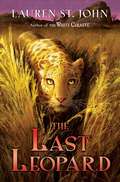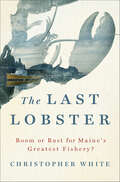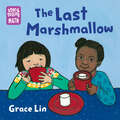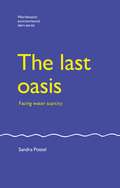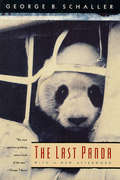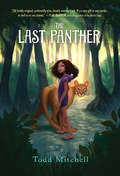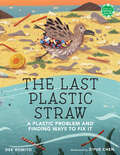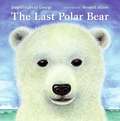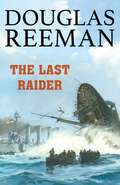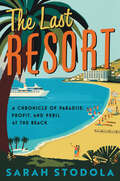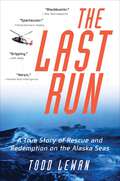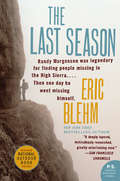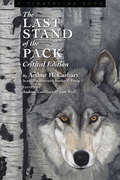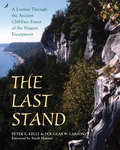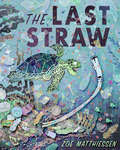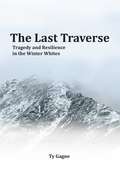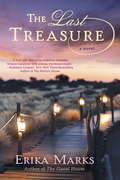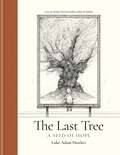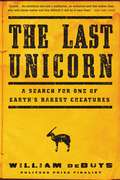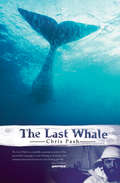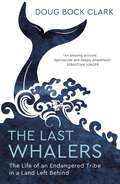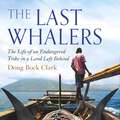- Table View
- List View
The Last Leopard (Legend of the Animal Healer #4)
by Lauren St. JohnA third prophecy, this time involving a leopard, comes true for eleven-year-old Martine, an orphaned South African girl who has mystical healing powers over animals, when she travels with her grandmother and best friend Ben to Zimbabwe.
The Last Lobster: Boom or Bust for Maine's Greatest Fishery?
by Christopher WhiteFrom the author of Skipjack & The Melting World comes a mystery: the curious boom in America’s beloved lobster industry and its probable crashMaine lobstermen have happened upon a bonanza along their rugged, picturesque coast. For the past five years, the lobster population along the coast of Maine has boomed, resulting in a lobster harvest six times the size of the record catch from the 1980s—an event unheard of in fisheries. In a detective story, scientists and fishermen explore various theories for the glut. Leading contenders are a sudden lack of predators and a recent wedge of warming waters, which may disrupt the reproductive cycle, a consequence of climate change.Christopher White's The Last Lobster follows three lobster captains—Frank, Jason, and Julie (one the few female skippers in Maine)—as they haul and set thousands of traps. Unexpectedly, boom may turn to bust, as the captains must fight a warming ocean, volatile prices, and rough weather to keep their livelihood afloat. The three captains work longer hours, trying to make up in volume what they lack in price. As a result, there are 3 million lobster traps on the bottom of the Gulf of Maine, while Frank, Jason, and others call for a reduction of traps, which may boost prices. The Maine lobstering towns are among the first American communities to confront global warming, and the survival of the Maine Coast depends upon their efforts.It may be an uphill battle to create a sustainable catch as high temperatures are already displacing lobsters northward toward Canadian waters—out of reach of American fishermen. The last lobster may be just ahead.
The Last Marshmallow (Storytelling Math)
by Grace LinCaldecott Honor winner Grace Lin celebrates math for every kid, everywhere!After playing in the snow, Olivia and Mei are ready for cocoa. There's one marshmallow for Olivia and one marshmallow for Mei. But what will they do with the third marshmallow? How can two friends share three things fairly?Storytelling Math celebrates children using math in their daily adventures as they play, build, and discover the world around them. Joyful stories and hands-on activities make it easy for kids and their grown-ups to explore everyday math together. Developed in collaboration with math experts at STEM education nonprofit TERC, under a grant from the Heising-Simons Foundation.
The Last Mixtape: Physical Media and Nostalgic Cycles
by Seth LongA reflection on the evolution of physical media into metaphor, through the history of music curation. Obsolescence makes the heart grow fonder, at least in the case of the mixtape. Not all technologies are so lucky. Some (say, wax cylinders) fade almost completely from cultural memory. A lucky few pass into metaphor: we still “hang up” our smartphones, “cut” film, and “patch” computer code. As digital streaming completes the obsolescence of physical media, what will become of the humble cassette? In The Last Mixtape, Seth Long offers a microhistory of music curation, anchored by the cassette, from which he explores the meanings of obsolescence, ownership, nostalgia, and the speed of cultural change. A moving meditation on our relationship with music, memory, and curation in the digital century, Long ultimately calls for a return to the media ecology represented by the mixtape: a world in which media is cheap and abundant but tactile and meaningfully engaged.
The Last Oasis: Facing Water Scarcity
by Sandra PostelFor decades now we have wasted and mismanaged the world?s water supplies. Today, 27 countries are short of water, a quarter of the world?s population has no safe water, 46 per cent have no proper sanitation and each year four million children die of water-borne diseases. As most of the world?s major river systems cross several national boundaries, the scope disputes and the threat to international security is becoming more and more real. In The Last Oasis, Sandra Postel examines the economic, ecological and political factors affecting fresh water supply. She confronts the issues of mismanagement and profligacy and analyses and dangers of confrontation, both between nations and between rural and urban users. She also emphasises that the technology and know-how for effective water husbandry does exist. With methods already in use, farmers could cut their demand for water by 40-90 per cent, and cities by one-third, without sacrificing economic output or quality of life. Investing in water efficiency, recycling and conservation help meet rising demands and stave off disaster. But the priority is a common recognition of the gravity of the position, and with that a widespread push for institutions to manage sustainable use of water.
The Last Panda
by George B. SchallerDependent on a shrinking supply of bamboo, hunted mercilessly for its pelt, and hostage to profiteering schemes once in captivity, the panda is on the brink of extinction. Here, acclaimed naturalist George Schaller uses his great evocative powers, and the insight gained by four and a half years in the forests of the Wolong and Tangjiahe panda reserves, to document the plight of these mysterious creatures and to awaken the human compassion urgently needed to save them. "No scientist is better at letting the rest of us in on just how the natural world works; no poet sees the world with greater clarity or writes about it with more grace. . . . Anyone who genuinely cares for wildlife cannot help being grateful to Schaller-both for his efforts to understand the panda and for the candor with which he reports what has gone so badly wrong in the struggle to save it from extinction. "-Geoffrey C. Ward, New York Times Book Review "Schaller's book is a unique mix of natural history and the politics of conservation, and it makes for compelling reading. . . . Having been in giant panda country myself, I found some of the descriptions of the animals and habitats breathtaking. Schaller describes the daily routines and personalities of the giant pandas he studied (as well as their fates thereafter) as though they were his blood relatives. . . . Schaller's brilliant presentation of the complexities of conservation makes his book a milestone for the conservation movement. "-Devra G. Kleiman, Washington Post Book World "George Schaller's most soulful work, written in journal style with many asides about a creature who evolved only two to three million years ago (about the same time as humans). . . . Here, conservation biology confronts an evil that grinds against hope and shatters the planet's diversity. Written with hope. "-Whole Earth Catalog "A nicely crafted blend of wildlife observation and political-cultural analysis. . . . The Last Panda is a sad chronicle of our failure, so far, to stem the decline of the animal that may be the most beloved on the planet. "-Donald Dale Jackson, Smithsonian
The Last Panther
by Todd MitchellFor animal lovers and fans of The One and Only Ivan and Hoot, this is the uplifting story of a girl who discovers a family of panthers that were thought to be extinct, and her journey to save the species. Eleven-year-old Kiri has a secret: wild things call to her. More than anyone else, she’s always had a special connection to animals. But when Kiri has an encounter with the last known Florida panther, her life is quickly turned on end. Caught between her conservationist father, who wants to send the panther to a zoo, and the village poachers, who want to sell it to feed their families, Kiri must embark on a journey that will take her deep into the wilderness. There has to be some way to save the panther, and for her dad and the villagers to understand each other. If Kiri can’t figure out what it is, she’ll lose far more than the panthers—she’ll lose the only home she’s ever known, and the only family she has left."A powerful tale of a future to be avoided." —Kirkus Reviews"An eerie cautionary tale about the dangers of not protecting the environment, tackles an important theme in a compelling way...a fantastical tale with roots in real-world issues." —Booklist"Earnest, heartfelt, and passionate, this book will likely inspire new environmentalists." —Bulletin"A boldly original, profoundly wise, deeply moving book. It’s a rare gift to any reader, as well as to our planet.” —T. A. Barron, best-selling author of the Merlin Saga
The Last Plastic Straw: A Plastic Problem and Finding Ways to Fix It (Books for a Better Earth)
by Dee RomitoLearn how and why a useful, 5000-year-old invention has become a threat to our planet—and what you can do about it—in this history of the simple straw. <P><P> From reeds used by ancient Sumerians to bendy straws in World War II hospitals, people have changed the straw to fit their needs for 5000 years. Today however, this useful tool is contributing to the plastic problem polluting our oceans. Once again, the simple straw needs a reinvention. <P><P> With bright illustrations and well-researched text, children can read about the inventors behind the straw’s technological advancements, including primary sources like patents, as well as how disposable plastic harms the environment. See the newest solutions, from plastic straw alternatives to activism by real kids like Milo Cress who started the Be Straw Free campaign when he was 11 years old. <P><P> Learn about what kids can do to reduce plastic waste. The backmatter includes more information on the movement to stop plastic waste, action items kids can do, a bibliography, and additional resources on plastic pollution. <P><P><i>Advisory: Bookshare has learned that this book offers only partial accessibility. We have kept it in the collection because it is useful for some of our members. Benetech is actively working on projects to improve accessibility issues such as these.</i>
The Last Polar Bear
by Jean Craighead GeorgeTigluk and his grandmother paddle out into the Arctic Ocean, where they find a young polar bear whose mother has died because of the changes brought about by the warming climate, and they bring the cub back to their town so they can teach it how to survive in a changing world.
The Last Raider
by Douglas ReemanDecember 1917: Germany opens the final, bitter round of the war with a new and deadly weapon in the struggle for the seas. When the Vulkan sails from Kiel Harbour, to all appearances she is a harmless merchant vessel. But her peaceful lines conceal a merciless firepower of guns, mines, and torpedoes that can be brought into play instantly. For the Vulkan is the last of the German commerce raiders, tasked with breaking through the British blockade and then heading west and south to the open seas. And under crack commander Felix von Steiger, her mission is to bring chaos to the Allied seaways.
The Last Resort: A Chronicle of Paradise, Profit, and Peril at the Beach
by Sarah StodolaA captivating exploration of beach resort culture—from its roots in fashionable society to its undervalued role in today’s world economy—as the travel industry approaches a climate reckoningWith its promise of escape from the strains of everyday life, the beach has a hold on the popular imagination as the ultimate paradise. In The Last Resort, Sarah Stodola dives into the psyche of the beachgoer and gets to the heart of what drives humans to seek out the sand. At the same time, she grapples with the darker realities of resort culture: strangleholds on local economies, reckless construction, erosion of beaches, weighty carbon footprints, and the inevitable overdevelopment and decline that comes with a soaring demand for popular shorelines.The Last Resort weaves Stodola’s firsthand travel notes with her exacting journalism in an enthralling report on the past, present, and future of coastal travel. She takes us from Monte Carlo, where the pursuit of pleasure first became part of the beach resort experience, to a village in Fiji that was changed irrevocably by the opening of a single resort; from the overdevelopment that stripped Acapulco of its reputation for exclusivity to Miami Beach, where extreme measures are underway to prevent the barrier island from vanishing into the ocean.In the twenty-first century, beach travel has become central to our globalized world—its culture, economy, and interconnectedness. But with sea levels likely to rise at least 1.5 to 3 feet by the end of this century, beaches will become increasingly difficult to preserve, and many will disappear altogether. What will our last resort be when water begins to fill the lobbies?
The Last Run: A True Story of Rescue and Redemption on the Alaska Seas
by Todd LewanIt was a desperate mission that made front-page headlines and captured the attention of millions of readers around the world. In January 1998, in the dead of an Alaskan winter, a cataclysmic Arctic storm with hurricane-force winds and towering seas forced five fishermen to abandon their vessel in the Gulf of Alaska and left them adrift in thirty-eight-degree water with no lifeboat. Their would-be rescuers were 150 miles away at the Coast Guard station, with the nearby airport shut down by an avalanche.The Last Run is the epic tale of the wreck of the oldest registered fishing schooner in Alaska, a hellish Arctic tempest, and the three teams of aviators in helicopters who withstood 140-mph gusts and hovered alongside waves that were ten stories high. But what makes this more than a true-life page-turner is its portrait of untamed Alaska and the unflappable spirit of people who forge a different kind of life on America's last frontier, the "end of the roaders" who are drawn to, or flee to, Alaska to seek a final destiny.
The Last Season
by Eric BlehmDestined to become a classic of adventure literature, The Last Season examines the extraordinary life of legendary backcountry ranger Randy Morgenson and his mysterious disappearance in California's unforgiving Sierra Nevada--mountains as perilous as they are beautiful. Eric Blehm's masterful work is a gripping detective story interwoven with the riveting biography of a complicated, original, and wholly fascinating man.
The Last Season
by Eric BlehmDestined to become a classic of adventure literature, The Last Season examines the extraordinary life of legendary backcountry ranger Randy Morgenson and his mysterious disappearance in California's unforgiving Sierra Nevada--mountains as perilous as they are beautiful. Eric Blehm's masterful work is a gripping detective story interwoven with the riveting biography of a complicated, original, and wholly fascinating man.
The Last Song of the World
by Joseph FasanoJoseph Fasano’s The Last Song of the World delves into the chaos of the modern world, and searches for resilience in the face of environmental and societal devastation. Dripping with images of ancient ruins and mythological figures, these poems serve as vignettes of fatherhood, love, and desire against the backdrop of apocalyptic events.Through the documentation of ongoing violence and natural phenomena, Fasano depicts the ever-present anxieties of parenting with concision and compassion. The Last Song of the World is a love letter to the world that could be, a world as tender as it is bold, as loving as it is brutal, as beautiful as it is horrendous.
The Last Stand of the Pack: Critical Edition (Timberline Books)
by Arthur CarhartThis critical edition explores the past and future of wolves in Colorado. Originally published in 1929, The Last Stand of the Pack is a historical account of the extermination of what were then believed to be the last wolves in Colorado. Arthur H. Carhart and Stanley P. Young describe the wolves’ extermination and extoll the bravery of the federal trappers hunting them down while simultaneously characterizing the wolves as cunning individuals and noble adversaries to the growth of the livestock industry and the settlement of the West. This is nature writing at its best, even if the worldview expressed is at times jarring to the twenty-first-century reader. Now, almost 100 years later, much has been learned about ecology and the role of top-tier predators within ecosystems. In this new edition, Carhart and Young’s original text is accompanied by an extensive introduction with biographical details on Arthur Carhart and an overview of the history of wolf eradication in the west; chapters by prominent wildlife biologists, environmentalists, wolf reintroduction activists, and ranchers Tom Compton, Bonnie Brown, Mike Phillips, Norman A. Bishop, and Cheney Gardner; and an epilogue considering current issues surrounding the reintroduction of wolves in Colorado. Presenting a balanced perspective, these additional chapters address views both in support of and opposed to wolf reintroduction. Coloradans are deeply interested in wilderness and the debate surrounding wolf reintroduction, but for wolves to have a future in Colorado we must first understand the past. The Last Stand of the Pack: Critical Edition presents both important historical scholarship and contemporary ecological ideas, offering a complete picture of the impact of wolves in Colorado.
The Last Stand: A Journey Through the Ancient Cliff-Face Forest of the Niagara Escarpment
by Doug Larson Peter E. Kelly Sarah HarmerThe most ancient and least disturbed forest ecosystem in eastern North America clings to the vertical cliffs of the Niagara Escarpment. Prior to 1988 it had escaped detection even though the entire forest was in plain view and was being visited by thousands upon thousands of people every year. The reason no one had discovered the forest was that the trees were relatively small and lived on the vertical cliffs of the Niagara Escarpment. The Last Stand reveals the complete account of the discovery of this ancient forest, of the miraculous properties of the trees forming this forest (eastern white cedar), and of what is was like for researchers to live, work and study within this forest. The unique story is told with text, with stunning colour photographs and through vivid first-hand accounts. This book will stand the test of time as a testament to science, imagination and discovery.
The Last Straw
by Zoe MatthiessenMeet Sippy, the world's last plastic strawSippy, a plastic straw who was used once and then discarded, worries what will happen to him when he realizes he can't be recycled. As he flies, floats, and flutters around the planet, he meets animals who are struggling with the plastic problem. He chats with a raccoon with a six-pack ring around his neck, a cardinal whose nest is made entirely of junk, turtles who confuse grocery bags with food, a hermit crab forced to live in a plastic cap, and a startled duck who runs around with a chip bag on her head. Finally, Sippy is swallowed by a hungry whale who is dining on ocean trash! Just when all hope seems lost, he skyrockets to freedom and calls out "Together we can fix this! Let's clean our world--let's try!"Parents and teachers of children 7 to 10 years old can use Sippy's colorful adventure--based on real examples of animals in our environment--to raise awareness about the impacts of plastics on nature and to teach children about alternatives to single-use plastics.
The Last Traverse: Tragedy And Resilience In The Winter Whites
by Ty GagneOn a mountain somewhere above treeline, in some of the coldest and worst winter conditions imaginable, two men lie unconscious in the snow as explosive winds batter the nearby summits. In The Last Traverse; Tragedy and Resilience in the Winter Whites, Ty Gagne masterfully lays out the events that led up to an epic and legendary rescue attempt in severe and dangerous winter conditions in the White Mountains of New Hampshire. More than a cautionary tale, it is a tribute to all the volunteers and professionals who willingly put themselves in harm's way to save lives. This is a must read for anyone who hikes the Whites. "In his first book, Where You'll Find Me: Risk, Decisions, and the last Climb of Kate Matrosova, Ty Gagne established his credentials as a writer of well-researched and objective analysis of mountain accidents. Moreover, Where You'll Find Me reads like a novel, a book I couldn't put down. In his latest book, The Last Traverse, Gagne takes the combination of analysis and storytelling to a new level in a tale of survival and tragedy in the White Mountains." -Mark Synnott, author of The Impossible Climb: Alex Honnold, El Capitan, and the Climbing Life and The Third Pole: Mystery, Obsession, and Death on Mount Everest
The Last Treasure
by Erika MarksFrom the author of It Comes in Waves and The Guest House comes a novel of three lives entangled in the secrets of the sea and the enduring bonds of love.As students with a shared passion for shipwrecks, Liv, Sam, and Whit formed a close bond searching for the mysterious Patriot, a schooner that disappeared off the Carolina Coast in 1812 with Aaron Burr's daughter Theodosia aboard. But as the elusive ship drew them together, love would bring them even closer--and ultimately tear them apart.It's been nine years since Liv left Sam to be with Whit, and the once close-knit triowent their separate ways. Liv has given up her obsession with Theodosia Burr to focus on her career as a salvage diver and her passionate but troubled marriage to the reckless and hedonistic Whit. But when a diary of Theodosia's is discovered in a collector's estate, she is pulled back to the world of the Patriot, this time with startling new clues to what might have really happened. Diving back into the lost history of the Patriot could be just what Liv needs to find closure to a mystery that still haunts her. But when she and Whit reunite with Sam for one last salvage in North Carolina's Outer Banks, buried romantic tensions begin to resurface, and once again Liv must choose between two men with very different hearts.From the Trade Paperback edition.
The Last Tree: A Seed of Hope
by Luke Adam HawkerFrom the Sunday Times bestselling author of Together. Imagine a world without trees. A world that is in many ways like our world, but where magnificent canopies, tree climbing and leaves rustling in the breeze are now only distant memories.Until a young girl comes along, a girl who is brave and spirited and willing to follow where her imagination takes her. Through Olive's adventures in the world of trees we are reminded of nature's extraordinary power and beauty, and her actions ultimately sow the seeds of new life in her own world.From the mind and pen of bestselling author Luke Adam Hawker, The Last Tree is a powerful evocation of the fragility of our natural world and a magnificent celebration of its beauty.Praise for Together:"An accurate and thoughtful account of one of the most challenging years in modern history." -The Guardian"Hawker's images always seem to have just the right mixture of gravitas and sly, understated humour." -The Scotsman
The Last Unicorn: A Search for One of Earth's Rarest Creatures
by William DebuysAn award-winning author's stirring quest to find and understand an elusive and exceptionally rare species in the heart of Southeast Asia's jungles.In 1992, in a remote mountain range, a team of scientists discovered the remains of an unusual animal with beautiful long horns. It turned out to be a living species new to western science -- a saola, the first large land mammal discovered in 50 years.Rare then and rarer now, no westerner had glimpsed a live saola in the wild before Pulitzer Prize finalist and nature writer William deBuys and conservation biologist William Robichaud set off to search for it in the wilds of central Laos. The team endured a punishing trek, up and down whitewater rivers and through mountainous terrain ribboned with the snare lines of armed poachers.In the tradition of Bruce Chatwin, Colin Thubron, and Peter Matthiessen, THE LAST UNICORN is deBuys's look deep into one of the world's most remote places. As in the pursuit of the unicorn, the journey ultimately becomes a quest for the essence of wildness in nature, and an encounter with beauty.
The Last Whale
by Chris PashAt the end of the 1970s, one young reporter bears witness to the final days of Australia’s whaling industry. Thirty years after the last whale was captured and slaughtered in Australia, this incisive account tells the very human story of the characters and events that brought whaling to an end. This fair and balanced account portrays the raw adventure of going to sea, the perils of being a whaler, and the commitment that leads activists to throw themselves into the path of an explosive harpoon. Accompanied by a wonderful photographic record of the time, this is the action-packed history of a town reliant on whaling dollars pitted against a determined band of protesters.
The Last Whalers: The Life of an Endangered Tribe in a Land Left Behind
by Doug Bock Clark'Remarkable... a rich, novelistic account based on diligent reporting ... An empathetic, even intimate account, but not a dewy-eyed one ... Wonderful' Daily Telegraph'I absolutely loved this magnificent book' Sebastian Junger'A monumental achievement' Mitchell Zuckoff'[An] immersive, densely reported and altogether remarkable first book ... The Last Whalers has the texture and colouring of a first-rate novel' New York TimesAt a time when global change has eradicated thousands of unique cultures, The Last Whalers tells the stunning inside story of the Lamalerans, an ancient tribe of 1,500 hunter-gatherers who live on a volcanic island so remote it is known by other Indonesians as "The Land Left Behind." They have survived for centuries by taking whales with bamboo harpoons, but now are being pushed toward collapse by the encroachment of the modern world.Award-winning journalist Doug Bock Clark, who lived with the Lamalerans across three years, weaves together their stories with novelistic flair to usher us inside this hidden drama. Jon, an orphaned apprentice whaler, strives to earn his harpoon and feed his ailing grandparents. Ika, Jon's indomitable younger sister, struggles to forge a modern life in a tradition-bound culture and realize a star-crossed love. Ignatius, a legendary harpooner entering retirement, labors to hand down the Ways of the Ancestors to his son, Ben, who would rather become a DJ in the distant tourist mecca of Bali.With brilliant, breathtaking prose and empathetic, fast-paced storytelling, Clark details how the fragile dreams of one of the world's dwindling indigenous peoples are colliding with the irresistible upheavals of our rapidly transforming world, and delivers to us a group of families we will never forget.
The Last Whalers: The Life of an Endangered Tribe in a Land Left Behind
by Doug Bock Clark'Remarkable... a rich, novelistic account based on diligent reporting ... An empathetic, even intimate account, but not a dewy-eyed one ... Wonderful' Daily Telegraph'I absolutely loved this magnificent book' Sebastian Junger'A monumental achievement' Mitchell ZuckoffThe epic story of the world's last subsistence whalers.At a time when global change has eradicated thousands of unique cultures, The Last Whalers tells the stunning inside story of the Lamalerans, an ancient tribe of 1,500 hunter-gatherers who live on a volcanic island so remote it is known by other Indonesians as "The Land Left Behind." They have survived for centuries by taking whales with bamboo harpoons, but now are being pushed toward collapse by the encroachment of the modern world.Award-winning journalist Doug Bock Clark, who lived with the Lamalerans across three years, weaves together their stories with novelistic flair to usher us inside this hidden drama. Jon, an orphaned apprentice whaler, strives to earn his harpoon and feed his ailing grandparents. Ika, Jon's indomitable younger sister, struggles to forge a modern life in a tradition-bound culture and realize a star-crossed love. Ignatius, a legendary harpooner entering retirement, labors to hand down the Ways of the Ancestors to his son, Ben, who would rather become a DJ in the distant tourist mecca of Bali.With brilliant, breathtaking prose and empathetic, fast-paced storytelling, Clark details how the fragile dreams of one of the world's dwindling indigenous peoples are colliding with the irresistible upheavals of our rapidly transforming world, and delivers to us a group of families we will never forget.(P)2019 Hodder & Stoughton Limited
